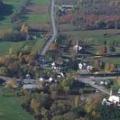 Nestled between luscious green valleys on the banks of the Brochets River, close to Mount Pinacle and the American border, Frelighsburg is home to a particularly special architectural heritage as is reflected in the importance, originality and preservation of its buildings. Its proximity to the United States meant this village became a place where many cross-border immigrants would eventually settle. The first wave of immigrants arrived in 1790, among them Abram Freligh, who gave the village its name upon acquiring the sawmill. The second mill, built on the river's edge by Freligh’s son in 1839, is now a historical monument and is private property. Frelighsburg began expanding throughout the 19th century, with side-by-side construction of American-style stone and wooden buildings.
Nestled between luscious green valleys on the banks of the Brochets River, close to Mount Pinacle and the American border, Frelighsburg is home to a particularly special architectural heritage as is reflected in the importance, originality and preservation of its buildings. Its proximity to the United States meant this village became a place where many cross-border immigrants would eventually settle. The first wave of immigrants arrived in 1790, among them Abram Freligh, who gave the village its name upon acquiring the sawmill. The second mill, built on the river's edge by Freligh’s son in 1839, is now a historical monument and is private property. Frelighsburg began expanding throughout the 19th century, with side-by-side construction of American-style stone and wooden buildings.
The co-existence of an Anglican church (built in 1880) and a Catholic church (built in 1883) epitomizes the cultural diversity of the region. Other attractions are the presbytery (1887), the convent (1914) and the former home of Joseph Lansberg, which today serves as a café-restaurant specializing in maple syrup products.
In 1866 and 1870, Frelighsburg was the setting of two uprisings led by the Fenians, a group of Irish immigrants to the United States, who tried to blackmail England into granting independence to their homeland by holding Lower Canada captive! However, put to rout the first time, and disarmed the second time, they returned in 1870 only to be defeated.
Frelighsburg is surrounded by apple orchards, and stretches all the way to the base of Mount Pinacle, which offers dazzling blossom views in the springtime. The cultivation of apple trees began by the end of the 1920s, and some were even grown on the property of former provincial premier, Adélard Godbout. This property is known today as the Trois-Ruisseaux Farm. Frelighsburg can be seen by car along a number of scenic roads: Chemin Eccles Hill (which winds up alongside the river), Chemin Saint-Armand (which is lined by trees and dotted with farms, orchards and wooded parks), Chemin du Verger, and Chemin Richford, a panoramic road through the orchards that offers views of the Appalachian mountains.
Close by, Mount Pinacle offers many bike paths to be explored.